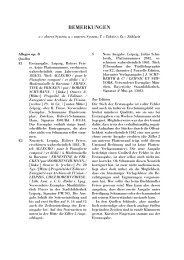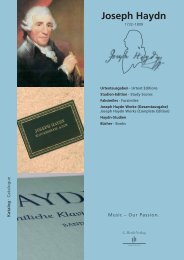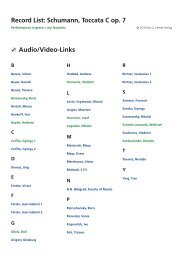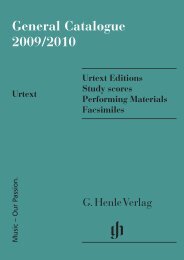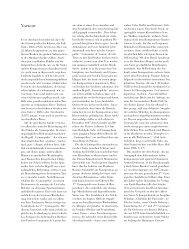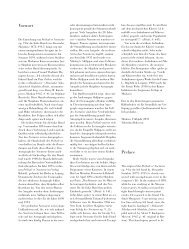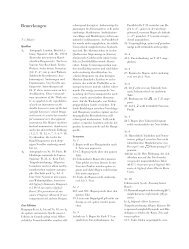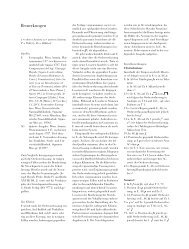Erfolgreiche ePaper selbst erstellen
Machen Sie aus Ihren PDF Publikationen ein blätterbares Flipbook mit unserer einzigartigen Google optimierten e-Paper Software.
46<br />
<strong>Bemerkungen</strong><br />
A = Autograph; AB = Franchommes Abschrift<br />
der Cellostimme; F = Französische<br />
Erstausgabe; D = Deutsche Erstausgabe;<br />
M = Ausgabe von Chopins<br />
Schüler Carl Mikuli; St = Französische<br />
Erstausgabe aus dem Besitz von<br />
Chopins Schülerin Jane W. Stirling;<br />
Z = Handexemplar Zimmermann,<br />
Warschau (Exemplar der französischen<br />
Erstausgabe); Vc = Violoncello;<br />
T = Takt(e); o/u = oberes/unteres<br />
System<br />
Als Quellen dienten F (Brandus, Paris<br />
1847, Platten Nr. 4744), D (Breitkopf &<br />
Härtel, Leipzig 1847, Platten Nr. 7718),<br />
beide Österreichische Nationalbibliothek<br />
Wien, Sammlung Hoboken sowie A, aus<br />
einzeln und verstreut überlieferten Blättern<br />
zusammengestellt in folgender<br />
Faksimile-Ausgabe: The Work Sheets<br />
to Chopin’s Violoncello Sonata, hrsg.<br />
von Ferdinand Gajewski, Garland, New<br />
York & London 1988.<br />
A umfasst neben Skizzen die fast<br />
vollständige Niederschrift aller Sätze,<br />
allerdings in unterschiedlicher Qualität.<br />
Der erste Satz bietet bis auf wenige Details<br />
den endgültigen Notentext (das<br />
Blatt mit den Takten 71–90 fehlt). Der<br />
komplett notierte zweite Satz zeigt teilweise<br />
lediglich ein Entwurfsstadium,<br />
enthält aber auch endgültige Textabschnitte.<br />
Der dritte Satz stellt eine<br />
24taktige kompositorische Vorstufe zur<br />
endgültigen Gestalt dar. Der vierte Satz<br />
ist komplett in der Qualität des ersten<br />
Satzes niedergeschrieben. Das Autograph<br />
enthält zahlreiche Streichungen<br />
und Verbesserungen, die nicht immer<br />
leicht zu entziffern sind. Fehldeutungen<br />
lassen sich gelegentlich in den<br />
Drucken nachweisen. Bei allen Sätzen<br />
sind die Angaben zur Dynamik, Phrasierung<br />
und Artikulation nur sehr sparsam.<br />
Chopin muss sie in einer späteren<br />
Reinschrift auf der Grundlage von A<br />
oder in einer Kopistenabschrift von A<br />
eingetragen haben. Diese Bindeglieder,<br />
wie überhaupt die Stichvorlagen zu F<br />
und D, fehlen. AB (Bibliothèque natio-<br />
nale, Paris) ist ebenso wie das Cello in A<br />
nur rudimentär bezeichnet und kann<br />
nicht als Stichvorlage gedient haben.<br />
AB weicht in zahlreichen Lesarten von<br />
den übrigen Quellen ab.<br />
Das Abhängigkeitsverhältnis von F<br />
und D lässt sich nicht klar bestimmen.<br />
Franchomme war der Meinung, Chopin<br />
habe F Korrektur gelesen. Wir verwenden<br />
die Quellen F, D und A als Hauptquellen<br />
grundsätzlich im Rang der genannten<br />
Reihenfolge. Dort wo F und D<br />
die Textebene von A nicht übertreffen,<br />
kann gegebenenfalls, vor allem im Klavier,<br />
A den besseren Text bieten. Im<br />
Zweifelsfall aber geben wir F wieder,<br />
vor allem dann, wenn klar ist, dass erst<br />
im Druck die Schlusslesart einer Textstelle<br />
erreicht wurde. So geht die Cellostimme<br />
unserer Ausgabe hauptsächlich<br />
auf F und D zurück.<br />
Interessant ist, dass einige Verbesserungen<br />
der Cellostimme in A für F nicht<br />
übernommen wurden. F greift wieder<br />
auf die von Chopin bereits gestrichenen<br />
Fassungen zurück, andererseits bietet F<br />
neue Cellovarianten, z. B. Oktavverlegungen.<br />
Hier erkennt man die beratende<br />
Mitarbeit Franchommes. Als weitere<br />
Quellen wurden St, Z und M zu Rate gezogen.<br />
Kursive Angaben stammen aus<br />
den Quellen; eingeklammerte Zeichen<br />
fehlen in denselben. In der bezeichneten<br />
Stimme unserer Ausgabe wurden originale<br />
Fingersätze und Saitenangaben bewusst<br />
weder komplett wiedergegeben<br />
noch kursiv kenntlich gemacht. Das Nebeneinander<br />
originaler und moderner<br />
Angaben hätte zur Verwirrung geführt.<br />
Alle diese originalen Bezeichnungen<br />
finden sich aber in der unbezeichneten<br />
Stimme.<br />
1. Satz – Allegro moderato<br />
1: A hat Maestoso statt Allegro moderato.<br />
5: p nur in A.<br />
9 o: 2. Bogen in A, F und D von letzter<br />
Note a in T 9 zu 1. Note a in T 10.<br />
Solche nach moderner Praxis zu den<br />
Notenköpfen gesetzte Bögen werden<br />
im Folgenden zur Vermeidung funktionaler<br />
Fehldeutungen (Haltebogen<br />
statt Bindebogen) kommentarlos korrigiert.<br />
15 Vc: f in AB bereits auf 2. g 1 .<br />
19 u: In D 4. Viertel mit g statt a.<br />
30: Ped. in F und D wohl versehentlich<br />
schon beim 1. Achtel. A ohne Angabe.<br />
35: 11. Achtel in D in beiden Händen<br />
als Zweiklang e 1 /cis 2 bzw. e 2 /cis 3 .<br />
39 o: D hat Stakkatopunkt beim letzten<br />
Akkord.<br />
44 Vc: p gemäß AB; in F zwischen 1.<br />
und 2. Zählzeit, in D erst auf 2. Zählzeit.<br />
Fehlt in A.<br />
46 o: D notiert als vorletztes 16tel c 3<br />
statt d 3 .<br />
46 Vc: Letztes g nur in A und AB.<br />
47 o: 9. 16tel in D als des 2 .<br />
48: D hat Schwellgabel statt Abschwellgabel;<br />
A ohne Angabe.<br />
49 u: Akzente nur in A.<br />
50 u: F und D haben as 1 als 4. 16tel,<br />
aber ohne Akzent.<br />
59 o: D notiert c 1 statt d 1 .<br />
79 u: Die beiden Viertelnoten g fehlen<br />
in D; T 71 bis 90 fehlen in A (fehlendes<br />
Blatt).<br />
81 u: Ped. in F und D bereits beim 3.<br />
Achtel. A ohne Angabe.<br />
93 u: F und D notieren B statt Gis als<br />
sechstletztes 16tel; siehe aber die<br />
Parallelstellen; in A ist dieses 16tel<br />
unkenntlich gemacht worden.<br />
93, 95: 2. Akzent fehlt in den Drucken.<br />
Siehe aber T 207 und 209.<br />
93, 95 o: In A und D statt Halbenoten<br />
g 1 lediglich Achtelnoten g 1 . An der<br />
Parallelstelle T 207/209 Halbenoten<br />
in allen Quellen.<br />
94, 96 o: In F fehlt im 1. Akkord d 1 .<br />
Haltebögen zu diesem Akkord nur<br />
in D.<br />
97 o: In A notieren die Mittelstimmen<br />
hier und in T 211 bei den drei letzten<br />
Achteln as statt wie in T 99 bzw.<br />
213 v a. Diese Differenzierung des<br />
Autographs wurde in den Drucken<br />
nivelliert.<br />
110 u: 4. Viertel D 1/D in F und D eine<br />
kleine Terz höher. An der Parallelstelle<br />
T 224 haben A und F G 1/G,<br />
D dagegen B 1/B.<br />
111 o: F und D setzen Auflösungszeichen<br />
erst vor das 2. e; siehe aber<br />
T 225. A notiert in T 111 analog<br />
T 225.<br />
130 o: A hat als letzte Note ces 3 .
139 u: 6. Achtel in D gis 1 statt e 1 ; in A<br />
undeutlich.<br />
142–144 o: Die übergehaltenen Achtel<br />
fehlen in D; deshalb dort nur Zweistimmigkeit.<br />
146 u: F und D notieren auf Zählzeit<br />
drei g/a statt e/g/a.<br />
147 o: e 1 auf Zählzeit eins nur in A. F<br />
und D notieren g 1 /a 1 /e 2 /g 2 /a 2 .<br />
151 o: 2. Achtel in D f statt a.<br />
163 o: D hat als 1. Achtel d 2 statt c 2 .<br />
167: A hat beim 3. Akkord zusätzlich c<br />
und c 1 .<br />
167 Vc: Die gesonderte Stimme von F<br />
hat Bogen über ganzen Takt.<br />
173: D hat Schwellgabel in 2. Takthälfte.<br />
181 o: A hat c 1 /e 1 statt nur e 1 auf Zählzeit<br />
vier.<br />
197 o: D hat a 2 statt g 2 .<br />
198 u: A bringt auf 3. Zählzeit ebenfalls<br />
die Oktave. A notiert auch die<br />
16tel der 4. Zählzeit als Oktave; die<br />
beiden anderen 16tel sind nicht oktaviert.<br />
211 o: Siehe Bemerkung zu T 97.<br />
213 o: In A lautet letztes 16tel a 1 /c 2<br />
statt nur c 2 .<br />
223 Vc: In A und AB ab 3. 16tel bis<br />
zum vorletzten Achtel eine Oktave<br />
tiefer.<br />
226: sfz fehlt in D; stattdessen p auf<br />
1. Zählzeit. A ist ohne Bezeichnung.<br />
2. Satz – Scherzo<br />
4, 6, 8 o: Hier und an den zahlreichen<br />
Parallelstellen uneinheitliche Notierung<br />
auf Zählzeit zwei in den Quellen:<br />
teilweise gesonderter Viertelhals,<br />
teilweise stattdessen Viertelpause.<br />
Wir vereinheitlichen zu Viertelhals.<br />
55 o: F notiert im 1. Akkord f 1 statt e1 ,<br />
wohl weil in A unklar.<br />
65 o: 1. Akkord in D mit as2 .<br />
65 Vc: f gemäß AB; in F und D erst auf<br />
3. Zählzeit. Fehlt in A.<br />
79 u: 4. Achtel f 1 in A und D wie das 2.<br />
als gis1 notiert.<br />
94 u: F und D notieren 3. Viertel irrtümlich<br />
als Oktave A/a.<br />
106 o: Akkord des 3. Viertels in D und<br />
A zusätzlich mit e1 ; die tiefe Oktave A<br />
fehlt in A.<br />
118 o: In A und F fehlt es1 .<br />
119–121 Vc: Bogen gemäß Einzelstimme<br />
F, in Partitur nur bis T 120.<br />
120 ff. o: In D ist das 2. Viertel ohne c 1<br />
notiert, in T 121 und 123 ohne cis 1 ,<br />
in T 124 ohne d 1 , in T 127 ohne dis 1<br />
und in T 128 ohne e 1 .<br />
124 o: In F fehlen hier die Auflösungszeichen.<br />
128 o: In F fehlen hier die Erhöhungszeichen.<br />
133: A hat als Tempoangabe piu lento.<br />
134 o: D hat als vorletztes Achtel d 1 .<br />
139 o: D notiert d–g–d 1 statt d–d 1 –g.<br />
146 o: D hat d 1 als 1. Achtel.<br />
150 o: Vorletztes Achtel in D als e 1 .<br />
176 o: Die ersten drei Achtel in M g–b–<br />
cis 1 , ganz entgegen den Quellen.<br />
177 o: Letztes Achtel in F g.<br />
182 o: Letztes Achtel in F d.<br />
183 o: In D e–a–e 1 –h–f 1 statt e–e 1 –a–<br />
h–f 1 .<br />
187 o: D hat d–g–d 1 statt d–d 1 –g.<br />
200 Vc: Nachschlag zum Triller in F als<br />
Achtel notiert, in A ohne Nachschlag,<br />
in AB mit k vor e 1 .<br />
242 o: 1. Akkord in F und D wohl irrtümlich<br />
mit d 1 statt f 1 ; in A undeutlich.<br />
3. Satz – Largo<br />
13 Vc: Haltebogen fehlt in F in Partitur.<br />
In Stimme gesetzt. Fehlt auch in AB.<br />
14 f. u: A und D notieren nur die hohen<br />
Oktavtöne.<br />
20 Vc: D hat langen Bogen über 5. und<br />
6. Viertel; A ohne Bogen, AB hat zusätzlichen<br />
Bogen über 5. Viertel samt<br />
Nachschlag.<br />
4. Satz – Finale Allegro<br />
7 Vc: Portato nur in D.<br />
22 u: b nur in M.<br />
24 Vc: Haltebogen von es1 T24 zur<br />
1. Note es1 in T 25 fehlt in den Quellen.<br />
F und D haben allerdings Legatobogen<br />
von 2. Zählzeit T 24 bis zur<br />
1. Note T 25. Diese Legatobögen<br />
könnten den Haltebogen implizieren.<br />
An der Parallelstelle T 103 fehlt der<br />
Haltebogen wiederum in A, ist aber<br />
in F und D gegeben. Die Stelle ist diskussionswürdig,<br />
weil A solche Haltebögen<br />
sonst immer setzt (z. B. T 12<br />
und alle vergleichbaren Stellen),<br />
47<br />
während Legatobögen in A nur spärlich<br />
vorkommen. Siehe auch Bemerkung<br />
zu T 34 f.<br />
34 f. Vc: D hat Haltebogen von g 1 T 34<br />
zu g 1 T 35. Fehlt in A, AB und F. An<br />
der Parallelstelle T 113 in A, F, D<br />
ohne Haltebogen. Siehe auch Bemerkung<br />
zu T 24.<br />
53: Chopin notiert in A die 16tel der<br />
linken Hand präzis unter die 3. Triolennoten<br />
der rechten Hand. F sticht<br />
durchweg, aber nicht immer, entsprechend;<br />
D sticht modern: die 16tel<br />
werden nach der letzten Triolennote<br />
plaziert. Wir plädieren für die gleichzeitige<br />
Ausführung.<br />
54 Vc: Bogen in F und D (je Partitur)<br />
bereits ab letzter Note T 53; siehe<br />
aber die Stimmen von F und D sowie<br />
AB.<br />
55 u: k vor f nur in Z; dort handschriftlich<br />
nachgetragen und gemäß T 53,<br />
132, 134.<br />
60: M notiert entgegen den Quellen als<br />
1. Achtel der 3. Triole g 1 statt h 1 und<br />
im Bass als 6. Achtel H statt d.<br />
62 Vc: In A verbesserte Chopin auf der<br />
2. Zählzeit zu zwei Achteln; in T 139<br />
entsprechend.<br />
69 o: In F und D mit fis 3 wie in T 70.<br />
An der Parallelstelle T 144 fehlt das<br />
entsprechende c 3 jedoch in allen<br />
Quellen.<br />
74 u: F hat im 4. Viertel d/g/b/d 1 .<br />
82 o: In F und D c 1 statt as/c 1 .<br />
83 o: h 2 gemäß F und D; A ohne Vorzeichen.<br />
Chopin trägt in St die Fingersatzangabe<br />
2 zur drittletzten Achtelnote<br />
cis 2 und zwar direkt neben dem<br />
h ein. Damit ist h 2 bestätigt.<br />
84 Vc: b 1 gemäß A und F (Partitur und<br />
Stimme), je ohne Vorzeichen. D (Partitur<br />
und Stimme) mit h. D gründet<br />
wohl auf einer Fehleinschätzung von<br />
A. Chopin notierte zunächst in diesem<br />
Takt einen anderen melodischen<br />
Verlauf, der als viertletztes Achtel h 1<br />
mit h enthielt. Er strich dann alle Töne,<br />
nicht aber eigens das h, und notierte<br />
die neue etwas tiefere Lesart im<br />
selben System direkt unter den gestrichenen<br />
Noten. Dabei könnte leicht<br />
der falsche Eindruck entstehen, das<br />
alte h gelte für die neue vorletzte Note<br />
b 1 . AB auch ohne h.
48<br />
89 o: 2. Akkord in A ohne c 2 .<br />
93 o: 2. und 3. Akkord gemäß allen<br />
Quellen (vergleiche T 89 o).<br />
96 o: A notiert im 1. Viertel d 1 ohne<br />
Vorzeichen; auch die übrigen d 1 haben<br />
keine Vorzeichen in A.<br />
101 u: In A und D ist 7. Achtel mit h<br />
notiert; in F ohne Vorzeichen.<br />
104, 106 u: 6. Achtel in A in T 104 e, in<br />
T 106 d; F und D haben zweimal d.<br />
Siehe aber T 25, 27.<br />
128 f. Vc: Bogensetzung gemäß A; in F<br />
und D in T 128 Partitur und Stimme<br />
uneinheitlich, in T 129 in F und D in<br />
Partitur und Stimme übereinstimmend<br />
vier Bögen über je drei Noten.<br />
135 o: Vorletzte Achtelnote a 1 gemäß A;<br />
in F und D fis 1 . Vielleicht irrtümlich,<br />
weil in A aus fis 1 zu a 1 verbessert.<br />
Siehe auch T 56.<br />
137 o: 2. Viertel in F und D mit nachschlagendem<br />
16tel, ganz im Gegensatz<br />
zu T 66. – k im 4. Viertel nur<br />
in D.<br />
139 u: 2. Takthälfte in D ohne die Viertelnoten<br />
A und e.<br />
139 Vc: Siehe Bemerkung zu T 62.<br />
150 o: F hat als 2. Achtel c 2 .<br />
151 o: Letztes Achtel in F und D nur e 2<br />
statt cis 2 /e 2 . Siehe aber T 4.<br />
156 o: 1. Akkord in D ohne d 2 .<br />
171 o: A notiert a/h statt h, gis/h statt<br />
gis, a statt a/e 1 und e 1 /g 1 /a 1 statt<br />
e 1 /a 1 .<br />
176 Vc: A hat im 1. Viertel Triole<br />
a–g–h statt der beiden Achtel a–g.<br />
177 u: A hat auf 3. Zählzeit zwei Achtel<br />
statt Punktierung.<br />
181 o: D hat h statt c 1 im 4. Viertel.<br />
193 Vc: Im Autograph notiert die untere<br />
Stimme immer h; Chopin hatte zu<br />
h korrigiert, wodurch die Notierung<br />
nicht leicht zu entziffern ist. Das erklärt,<br />
wieso in F und D die drei letzten<br />
Achtel der Unterstimme fälschlich<br />
als g wiedergegeben werden.<br />
198 Vc: Arpeggio nur in A.<br />
Rheinberg, Frühjahr 1997<br />
Ewald Zimmermann<br />
Comments<br />
A = autograph score; MC = Franchomme’s<br />
manuscript copy of cello part; FE =<br />
French first edition; GE = German first<br />
edition; CM = edition prepared by Chopin’s<br />
pupil Carl Mikuli; FES = French<br />
first edition formerly owned by Chopin’s<br />
pupil Jane W. Stirling; FEZ = personal<br />
copy of French first edition owned by<br />
Zimmermann, Warsaw; vc = violoncello;<br />
M = measure(s); u/l = upper/lower staff<br />
The sources consulted for our edition<br />
include FE (Paris: Brandus, 1847, plate<br />
no. 4744) and GE (Leipzig: Breitkopf &<br />
Härtel, 1847, plate no. 7718), both of<br />
which are located in the Hoboken Collection<br />
of the Austrian National Library<br />
in Vienna, as well as A, which was collated<br />
from isolated and dispersed leaves<br />
and published in facsimile in The Work<br />
Sheets to Chopin’s Violoncello Sonata,<br />
edited by Ferdinand Gajewski (New<br />
York and London: Garland, 1988).<br />
Besides sketches, A contains a virtually<br />
complete draft of all four movements,<br />
albeit of varying quality. The<br />
first movement presents the final text<br />
apart from a few details (the leaf with<br />
bars 71–90 is missing). The second<br />
movement, although completely written<br />
out, is partly in the sketch stage although<br />
it, too, contains sections of the<br />
final text. The third movement presents<br />
a 24-bar preliminary draft for the final<br />
version. The fourth movement is completely<br />
written out with the same quality<br />
as the first movement. The autograph<br />
contains many cuts and emendations<br />
that are not always easy to decipher.<br />
Misinterpretations occasionally found<br />
their way into the prints. All the movements<br />
are very sparing in their use of<br />
dynamics, phrasing, and articulation<br />
marks. Chopin must have entered these<br />
marks later in a fair copy or copyist’s<br />
manuscript based on A. These connecting<br />
links in the source tradition are<br />
missing today, as are the engraver’s copies<br />
for FE and GE. MC (Bibliothèque<br />
nationale, Paris), like the cello part in<br />
A, has only rudimentary markings and<br />
cannot have served as a model for the<br />
engraving. MC departs from the other<br />
sources in many of its readings.<br />
The relation between FE and GE<br />
cannot be precisely determined. Franchomme<br />
believed that Chopin read the<br />
proofs of FE. We have taken FE, GE,<br />
and A as our principal sources in the order<br />
indicated. In those passages where<br />
FE and GE do not go beyond the textual<br />
level of A, particularly in the piano part,<br />
A may present the superior text. In cases<br />
of doubt, however, we have reproduced<br />
the text given in FE, especially<br />
when the final reading of a passage was<br />
only reached in print. Accordingly, the<br />
cello part of our edition derives primarily<br />
from FE and GE.<br />
Interestingly, several improvements<br />
to the cello part in A are not found in<br />
FE. FE reverts to versions Chopin had<br />
previously deleted, although it also offers<br />
new variants in the cello part, such<br />
as octave displacements. Here we detect<br />
the constructive advice of Franchomme.<br />
We have also consulted FES, FEZ, and<br />
CM as additional sources. Marks in italics<br />
stem from the sources; signs added<br />
in parentheses are missing in the sources.<br />
In the cello part marked by Claus<br />
Kanngießer, we have deliberately refrained<br />
from reproducing all the original<br />
fingerings and string indications or<br />
identifying them by italics, feeling that<br />
the juxtaposition of original and modern<br />
markings would only have caused<br />
confusion. All the original markings<br />
can, however, be found in the unmarked<br />
part.<br />
Movement 1 – Allegro moderato<br />
1: A gives Maestoso instead of Allegro<br />
moderato.<br />
5: p in A only.<br />
9 u: A, FE and GE extend second slur<br />
from final a in M 9 to first a in M 10.<br />
Slurs of this sort, which in modern<br />
usage are placed on the note heads,<br />
have been corrected below without<br />
comment to avoid misconstrual of<br />
their function (tie instead of slur).<br />
15 vc: MC already places f on second g1 .<br />
19 l: GE gives g on beat 4 instead of a.<br />
30: FE and GE already place Ped. on<br />
first eighth-note, probably by mistake.<br />
No pedal mark in A.
35: GE gives 11th eighth-note in both<br />
hands as, respectively, e 1 /ck 2 and<br />
e 2 /ck 3 .<br />
39 u: GE places staccato dot on final<br />
chord.<br />
44 vc: p taken from MC; placed between<br />
beats 1 and 2 in FE and on beat 2 in<br />
GE. Missing in A.<br />
46 u: GE gives next-to-last 16th as c 3<br />
instead of d 3 .<br />
46 vc: Final g appears in A and MC<br />
only.<br />
47 u: GE gives ninth 16th as db 2 .<br />
48: GE has crescendo hairpin instead of<br />
decrescendo hairpin; A unmarked.<br />
49 l: Accents in A only.<br />
50 l: FE and GE give fourth 16th as ab 1 ,<br />
but without accent.<br />
59 u: GE gives c 1 instead of d 1 .<br />
79 l: Both quarter-note g’s missing in<br />
GE; M 71 through 90 missing in A<br />
(missing leaf).<br />
81 l: FE and GE already place Ped. on<br />
third eighth-note. A unmarked.<br />
93 l: FE and GE give Bb instead of Gk<br />
as sixth 16th from end; however, see<br />
parallel passages; this 16th was made<br />
illegible in A.<br />
93, 95: Second accent missing in prints.<br />
However, see M 207 and 209.<br />
93, 95 u: A and GE merely have eighthnote<br />
g 1 instead of half-note g 1 . Given<br />
as half-notes by all sources in parallel<br />
passage M 207 and 209.<br />
94, 96 u: FE omits d 1 in first chord.<br />
Ties on this chord in GE only.<br />
97 u: A gives final three eighth-notes of<br />
middle parts in this bar and M 211 as<br />
as instead of v a, as in M 99 and<br />
213. This distinction in the autograph<br />
was ironed out in the prints.<br />
110 l: FE and GE give fourth quarternote<br />
D 1 /D a minor third higher. Parallel<br />
passage in M 224 given as G 1/G<br />
in A and FE, but as Bb 1 /Bb in GE.<br />
111 u: FE and GE postpone natural<br />
sign to second e; however, see M 225.<br />
M 111 made analogous to M 225<br />
in A.<br />
130 u: A gives final note as cb 3 .<br />
139 l: GE gives eighth-note 6 as gk 1<br />
instead of e 1 ; indistinct in A.<br />
142–144 u: Tied-over eighths missing<br />
in GE, which therefore has only twovoice<br />
texture here.<br />
146 l: FE and GE give g/a on beat 3<br />
instead of e/g/a.<br />
147 u: e 1 on beat 1 in A only. FE and<br />
GE give g 1 /a 1 /e 2 /g 2 /a 2 .<br />
151 u: GE gives f for eighth-note 2<br />
instead of a.<br />
163 u: GE gives d 2 for first eighth-note<br />
instead of c 2 .<br />
167: A has additional c and c 1 in third<br />
chord.<br />
167 vc: Separate part of FE has full-bar<br />
slur.<br />
173: GE has crescendo hairpin in second<br />
half of bar.<br />
181 u: A has c 1 /e 1 on beat 4 instead of<br />
only e 1 .<br />
197 u: GE has a 2 instead of g 2 .<br />
198 l: A likewise gives octave on beat 3.<br />
A also gives 16ths in beat 4 as octave;<br />
the two other 16ths not doubled at<br />
octave.<br />
211 u: See comment on M 97.<br />
213 u: A gives final 16th as a 1 /c 2 instead<br />
of only c 2 .<br />
223 vc: A and MC give notes from third<br />
16th to next-to-last eighth one octave<br />
lower.<br />
226: sfz missing in GE, which has p on<br />
beat 1 instead. A unmarked.<br />
Movement 2 – Scherzo<br />
4, 6, 8 u: The sources are inconsistent in<br />
their notation of beat 2 in these bars<br />
and the many parallel passages:<br />
sometimes separate quarter-note<br />
stem, sometimes quarter-note rest instead.<br />
We consistently give quarternote<br />
stem.<br />
55 u: FE has f 1 in first chord instead of<br />
e1 , probably because indistinct in A.<br />
65 u: GE gives first chord with ab2 .<br />
65 vc: f taken from MC; postponed to<br />
beat 3 in FE and GE, missing in A.<br />
79 l: Instead of f 1 , A and GE give<br />
eighth-note 4 as gk1 , as in eighthnote<br />
2.<br />
94 l: FE and GE mistakenly give quarter-note<br />
3 as octave A/a.<br />
106 u: Chord on beat 3 given with additional<br />
e1 in GE and in A, which lacks<br />
lower octave A.<br />
118 u: A and FE omit eb1 .<br />
119–121 vc: Slur taken from separate<br />
part of FE; ends on M 120 in score.<br />
49<br />
120 ff. u: GE gives quarter-note 2 without<br />
c 1 , without ck 1 in M 121 and 123,<br />
without d 1 in M 124, without dk 1 in<br />
M 127, and without e 1 in M 128.<br />
124 u: FE omits naturals here.<br />
128 u: FE omits sharps here.<br />
133: A gives piu lento as tempo mark.<br />
134 u: GE gives next-to-last eighth-note<br />
as d 1 .<br />
139 u: GE gives d–g–d 1 instead of<br />
d–d 1 –g.<br />
146 u: GE gives d 1 for first eighth-note.<br />
150 u: GE gives e 1 for next-to-last<br />
eighth-note.<br />
176 u: CM gives first three eighth-notes<br />
as g–bb–ck 1 , quite contrary to the<br />
sources.<br />
177 u: g given as final eighth-note in FE.<br />
182 u: d given as final eighth-note in FE.<br />
183 u: GE gives e–a–e 1 –b–f 1 instead<br />
of e–e 1 –a–b–f 1 .<br />
187 u: GE gives d–g–d 1 instead of<br />
d–d 1 –g.<br />
200 vc: Termination of trill written as<br />
eighth-notes in FE; missing in A,<br />
with k on e 1 in MC.<br />
242 u: FE and GE give first chord with<br />
d 1 instead of f 1 , probably by mistake;<br />
indistinct in A.<br />
Movement 3 – Largo<br />
13 vc: Tie missing in score of FE but<br />
present in part. Also missing in MC.<br />
14 f. l: A and GE only give upper notes<br />
of octaves.<br />
20 vc: GE has long slur on quarternotes<br />
5 and 6; no slur in A, additional<br />
slur on quarter-note 5 plus termination<br />
in MC.<br />
Movement 4 – Finale Allegro<br />
7 vc: Portato in GE only.<br />
22 l: b in CM only.<br />
24 vc: Tie from eb1 in M 24 to first eb1 in M 25 missing in sources. However,<br />
FE and GE have a legato slur from<br />
beat 2 of M 24 to note 1 of M 25. The<br />
tie may be implicit in these slurs. In<br />
the parallel passage in M 103 the tie<br />
is again missing in A but present in<br />
FE and GE. This passage deserves<br />
mention because A otherwise invariably<br />
includes such ties (e.g. in M 12<br />
and all comparable passages) but us-
50<br />
es slurs sparingly. See also comment<br />
on M 34 f.<br />
34 f. vc: GE has tie from g 1 in M 34 to<br />
g 1 in M 35. Missing in A, MC and FE.<br />
The parallel passage in M 113 appears<br />
without tie in A, FE and GE.<br />
See also comment on M 24.<br />
53: In A, Chopin writes the 16ths in the<br />
left hand directly beneath the third<br />
notes of the triplets in the right. FE<br />
reads similarly, although not always;<br />
GE uses modern notation, with 16ths<br />
positioned after the final note of the<br />
triplet. We argue for simultaneous<br />
execution.<br />
54 vc: FE (score) and GE (score) already<br />
start slur on final note of M 53;<br />
however, see MC and separate parts<br />
of FE and GE.<br />
55 l: k on f in FEZ only, where it was<br />
entered by hand for consistency with<br />
M 53, 132, 134.<br />
60: Unlike the sources, CM gives first<br />
eighth-note of triplet 3 as g 1 instead<br />
of b 1 and eighth-note 6 in bass as B<br />
instead of d.<br />
62 vc: In A, Chopin corrected beat 2<br />
to read two eighth-notes; same in<br />
M 139.<br />
69 u: FE and GE give f k 3 as in M 70.<br />
However, no source gives the corresponding<br />
c 3 in the parallel passage in<br />
M 144.<br />
74 l: FE gives quarter-note 4 as<br />
d/g/bb/d 1 .<br />
82 u: FE and GE give c 1 instead of ab/c 1 .<br />
83 u: b 2 taken from FE and GE; no accidental<br />
in A. In FES, Chopin entered<br />
fingering mark 2 on third-from-last<br />
eighth-note ck 2 , placing it directly<br />
next to the h and thereby confirming<br />
b 2 .<br />
84 vc: bb 1 taken from A and FE (score<br />
and part), but without accidental.<br />
Score and part of GE have h. GE is<br />
probably based on a misreading of A.<br />
At first Chopin wrote a different melodic<br />
line in this bar, with a b 1 plus h<br />
as the fourth eighth-note from the<br />
end. He then crossed out all the<br />
notes, leaving only the h, and wrote<br />
the new, slightly lower reading directly<br />
beneath the deleted notes in the<br />
same staff. This might easily convey<br />
the false impression that the old h applies<br />
to the new penultimate bb 1 . MC<br />
also omits h.<br />
89 u: A omits c 2 in second chord.<br />
93 u: Chords 2 and 3 as given in all<br />
sources (cf. M 89 u).<br />
96 u: A lacks accidental on d 1 in beat 1<br />
and on all other d 1 ’s as well.<br />
101 l: A and GE give h on eighth-note 7;<br />
no accidental in FE.<br />
104, 106 l: A gives sixth eighth-note as<br />
e in M 104 and d in M 106; FE and<br />
GE give two d’s. However, see M 25<br />
and 27.<br />
128 f. vc: Slurring taken from A; FE<br />
and GE (score and part) are inconsistent<br />
in M 128 but consistently give<br />
four three-note slurs in M 129.<br />
135 u: Penultimate eighth-note a 1 taken<br />
from A; FE and GE give f k 1 . Perhaps<br />
a mistake since f k 1 corrected to a 1 in<br />
A. See also M 56.<br />
137 u: Second quarter-note has off-beat<br />
16th in FE and GE, quite contrary to<br />
M 66. – k in beat 4 occurs in GE only.<br />
139 l: GE omits quarter-notes A and e<br />
in second half of bar.<br />
139 vc: See comment on M 62.<br />
150 u: FE gives eighth-note 2 as c 2 .<br />
151 u: Final eighth-note given as e 2 in<br />
FE and GE instead of ck 2 /e 2 . However,<br />
see M 4.<br />
156 u: GE omits d 2 in first chord.<br />
171 u: A gives a/b instead of b, gk/b<br />
instead of gk, a instead of a/e 1 , and<br />
e 1 /g 1 /a 1 instead of e 1 /a 1 .<br />
176 vc: A gives triplet a–g–b in beat 1<br />
instead of two eighth-notes a–g.<br />
177 l: A gives beat 3 with two eighthnotes<br />
rather than dotted.<br />
181 u: GE gives b instead of c 1 in<br />
beat 4.<br />
193 vc: The autograph consistently has<br />
b in the lower voice. Corrected to b<br />
by Chopin, which makes the notation<br />
difficult to decipher. This explains<br />
why FE and GE incorrectly render<br />
the final three eighth-notes in the<br />
lower voice as g.<br />
198 vc: Arpeggio in A only.<br />
Rheinberg, spring 1997<br />
Ewald Zimmermann



